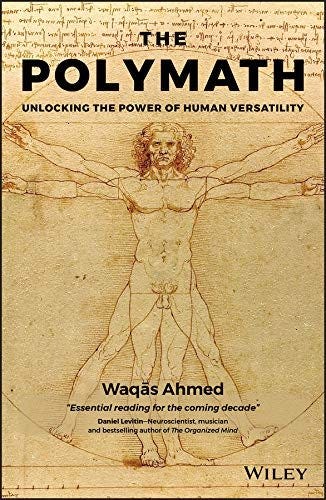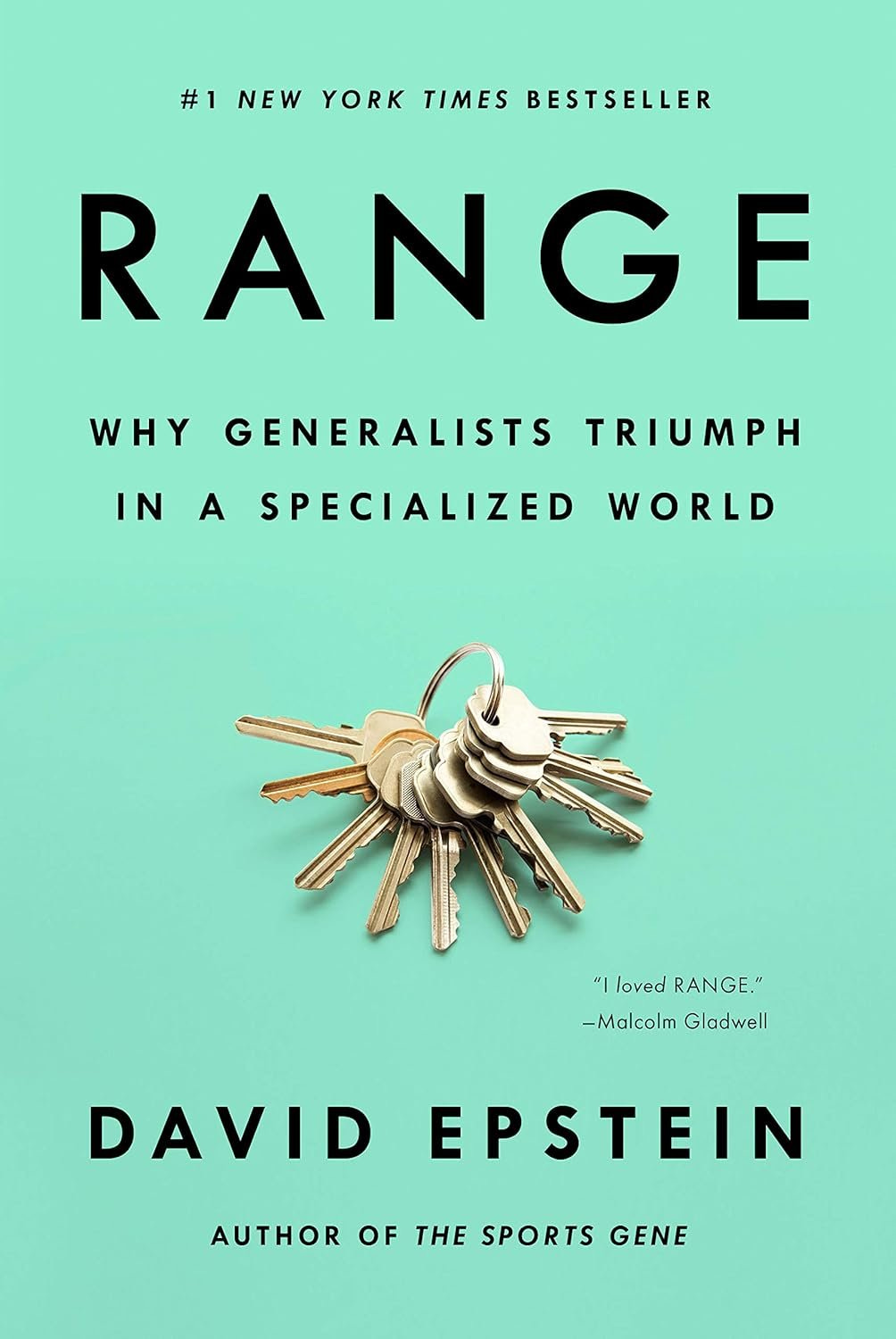Welcome to Polymathic Being, a place to explore counterintuitive insights across multiple domains. These essays take common topics and explore them from different perspectives and disciplines to uncover unique insights and solutions.
Today's topic revisits and simplifies the foundation of Polymathic Thinking. Over the past two years, I’ve received questions about how to start the journey as an aspiring Polymath, and this is my answer. Join in, and let’s start the journey together.
Intro
I’ve written many essays about the Polymathic Mindset, and we’ve approached the idea from multiple perspectives. However, there isn’t one essay that weaves them all together simply and easily. This will be the goal for today. You’ll get a clear foundation and see the threads of other counterintuitive insights weaving together, which you can follow as part of your adventure. We’ll introduce the first two foundational steps and then three fantastic books that help broaden your understanding. Without further ado, let’s dive in.
Step 1
The first step and the cornerstone of Polymathic Thinking is to Embrace Your White Belt with insatiable curiosity, humility, and intentional reframing so you can better approach complex situations and really understand multiple perspectives. I can’t emphasize enough how critical this step is.
Insatiable curiosity keeps you constantly challenging what you know and strives to avoid complacency. It also unlocks the excitement of learning new things and new ways of thinking. It’s a naturally playful idea allowing us to gently challenge what we think we know.
Humility helps us avoid overconfidence and hubris. I don’t believe a Polymath is a title or an end state but an aspiration; a guiding principle allowing us to pause and consider what we don’t know. It complements curiosity by honestly identifying our knowledge gaps.
Then, intentional reframing ensures we are looking at all the different perspectives to see if we understand the problem correctly. It’s a concept I refer to as “The Enemy’s Gate is Down” borrowing from the science fiction of Ender’s Game to look at things differently. Coupled with curiosity and humility, it allows us to consider a diversity of perspectives to fully appreciate the problem.
Step 2
With our white belts firmly tied, we can begin to grapple with the complex problems we find around us. As I wrote in Yes, And… So!, “In today’s political, technical, and even creative world, we aren’t facing simple problems. Our society is more interconnected and diverse, and the systems that underpin our standards of living are interdisciplinary and multidimensional. These systems architectures and infrastructure challenges have cascading consequences of systems of systems failures.” A Polymath needs to embrace this complexity and step back and even appreciate the larger complexities that surround it. It’s part of the intentional reframing but adds in even more. As Dwight Eisenhower said:
“Whenever I run into a problem I can't solve, I always make it bigger. I can never solve it by trying to make it smaller, but if I make it big enough, I can begin to see the outlines of a solution.“
This second step is essential to internalize: we must grapple with the complexity, play with it, and look for the commonality between ideas and across domains and disciplines. If you walk away with only two things, it’s embracing your white belt and the inherent complexity of the problems. Only then can we start to distill them down into actionable insights. These are the foundations of Polymathic Thinking.
Books to Read
Another question I’m asked is whether I’ve come to these insights myself or whether there are other resources available to help with the Polymathic journey. The short answer is, to quote Issac Newton, “If I have seen further it is because I have stood on the shoulders of giants.” The only thing I can claim credit for is fully embracing the foundation of Polymathic Thinking and then using that to try and uncover counterintuitive insights.
I’ll underline here that what we are talking about is a Polymathic Mindset. It’s a framework of thinking that allows you to apply a lot of different skill sets in the most effective way. This brings us to those Giants who introduced the mindset to me over the years.
First, let’s start with the absolute foundation that provided both the name and connected the dots of how my brain was already working. It wasn’t until I read The Polymath: Unlocking the Power of Human Versatility by Waqās Ahmed that I had a name for what I was doing and realized the superpower it was. This book is an easy, fun, and informative exploration of polymathy and its application to our world today. Waqās explains that we are born with a naturally curious mindset and specialization happens later. Chapter 5: Reconditioning the Mind, is a practical dive into establishing the mindset and was crucial to how I reframed my thinking.
The second book is Range: Why Generalists Triumph in a Specialized World by David Epstein, and challenges the conventional wisdom that early specialization leads to success. Instead, Epstein shows that generalists—those who explore a broad array of skills and knowledge—are more adaptable and innovative in complex and unpredictable environments. By exploring examples from sports, science, business, and technology, Epstein demonstrates that those who “sample” widely before specializing are better prepared to navigate the challenges of the modern world.
The third, and final book of the foundation trifecta is Where Good Ideas Come From by Steven Johnson which uncovers the patterns and environmental factors that foster innovation and creative breakthroughs. Johnson emphasizes the importance of collaborative networks, diverse perspectives, and serendipitous discoveries in sparking new ideas. He supports his findings by examining examples from biology, technology, and history showing that innovation often comes from the “adjacent possible” that is, the space just outside what is currently known.
Practical Application
I fully believe that Polymathic Thinking is a mindset that everyone can embrace. Where people struggle is when it forces them to break down the silos and barriers that have been erected around specialized domains and disciplines. A lot of us also struggle because, simply put, it’s uncomfortable to stretch our brains like that to continually explore new ideas and new ways of thinking.
This is why I find it works best within a community of aspiring polymaths. A dojo, if you will, of curious minds grappling with complex ideas and striving to continually learn, unlearn, and relearn. You don’t have to carry the challenge yourself, you can leverage humanity’s social superpower and learn from others.
Let me reiterate that last part and pull some threads. In the three books, The Polymath, Range, and Where Good Ideas Come From, a core element is the networks, relationships, and connections you make not just with information, but more importantly, with other people. It’s why I advocate embracing the divergents because that’s how you get wonderful insights and meet amazing new people.
There’s no ‘easy’ button and each time I write an essay, I’m unlearning and relearning along with everyone else. Polymathic Being is my journey, and I use it to challenge myself as much as I hope it provides insights for you. The final core element is that, along with insatiable curiosity and humility, it’s the application of these concepts to ourselves first before applying them to the world.
So join in, embrace your white belt, stretch your brain, look for the Yes, And… So! to understand the complexity, find people who think differently, constantly challenge your perspectives, and reframe the problems to see if there’s something new to learn. The power of Polymathic Thinking is that it challenges the status quo, provides unique insights, unlocks innovation, and, most importantly, helps us individually learn, unlearn, and relearn as we continually grow.
If you’re curious about applying the Polymathic Mindset at work, in your personal life, or anywhere, I offer 1:1 and group coaching as well as training for teams. You can schedule an introduction to find out how we can best bring Polymathy to you.
Enjoyed this post? Hit the ❤️ button above or below because it helps more people discover Substacks like this one and that’s a great thing. Also please share here or in your network to help us grow.
Polymathic Being is a reader-supported publication. Becoming a paid member keeps these essays open for everyone. Hurry and grab 20% off an annual subscription. That’s $24 a year or $2 a month. It’s just 50¢ an essay and makes a big difference.
Further Reading from Authors I Appreciate
I highly recommend the following Substacks for their great content and complementary explorations of topics that Polymathic Being shares.
- All-around great daily essays
- Fantastic introduction to Stoic Philosophy
- Insightful Life Tips and Tricks
- Highly useful insights into using AI for writing
- Integrating AI into education
- Computer Science for Everyone















Great article, particularly the books listed at the bottom. I have not read "Polymath," but I do have summaries of the latter two books in my online library of book summaries. Your readers might start there:
https://techratchet.com/2020/03/13/book-summary-range-why-generalist-triumph-in-a-specialized-world-by-daniel-epstein/
https://techratchet.com/2020/05/21/book-summary-where-good-ideas-come-from-by-steven-johnson/
Both are excellent, but I particularly like "Range."
My first go to, instinctively, is to make it bigger. This drives my husband insane. MOUHAHAHA
My favourite quote of all time.
"There is an infinite, thrumming, unseen web that joins everything. Everything is connected to everything else… this fact is nearly impossible for us to grasp because we are just mollusks, shut up tight at the bottom of a dark, cold ocean, trying to make sense of stars we cannot even see."
via The Finder (whose character, Walter Sherman, also made it bigger), via Bones and The Locator series of two books written by Richard Greener, via Galactica.